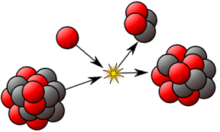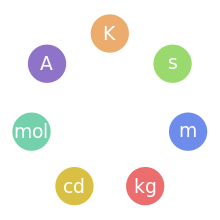List of equations in nuclear and particle physics
| Nuclear physics |
|---|
 |
| Nucleus · Nucleons (p, n) · Nuclear force · Nuclear structure · Nuclear reaction |
|
Nuclear models and stability |
|
Nucleosynthesis topics Nuclear fusion Processes: Stellar · Big Bang · Supernova Nuclides: Primordial · Cosmogenic · Artificial |
|
Scientists Alvarez · Becquerel · Bethe · A.Bohr · N.Bohr · Chadwick · Cockcroft · Ir.Curie · Fr.Curie · Pi.Curie · Skłodowska-Curie · Davisson · Fermi · Hahn · Jensen · Lawrence · Mayer · Meitner · Oliphant · Oppenheimer · Proca · Purcell · Rabi · Rutherford · Soddy · Strassmann · Szilárd · Teller · Thomson · Walton · Wigner |
This article summarizes equations in the theory of nuclear physics and particle physics.
Definitions
| Quantity (common name/s) | (Common) symbol/s | Defining equation | SI units | Dimension |
|---|---|---|---|---|
| Number of atoms | N = Number of atoms remaining at time t N0 = Initial number of atoms at time t = 0 |
dimensionless | dimensionless | |
| Decay rate, activity of a radioisotope | A | Bq = Hz = s−1 | [T]−1 | |
| Decay constant | λ | Bq = Hz = s−1 | [T]−1 | |
| Half-life of a radioisotope | t1/2, T1/2 | Time taken for half the number of atoms present to decay
|
s | [T] |
| Number of half-lives | n (no standard symbol) | dimensionless | dimensionless | |
| Radioisotope time constant, mean lifetime of an atom before decay | τ (no standard symbol) | s | [T] | |
| Absorbed dose, total ionizing dose (total energy of radiation transferred to unit mass) | D can only be found experimentally | N/A | Gy = 1 J/kg (Gray) | [L]2[T]−2 |
| Equivalent dose | H |
Q = radiation quality factor (dimensionless) |
Sv = J kg−1 (Sievert) | [L]2[T]−2 |
| Effective dose | E |
Wj = weighting factors corresponding to radiosensitivities of matter (dimensionless) |
Sv = J kg−1 (Sievert) | [L]2[T]−2 |
Equations
Nuclear structure
Physical situation Nomenclature Equations Mass number - A = (Relative) atomic mass = Mass number = Sum of protons and neutrons
- N = Number of neutrons
- Z = Atomic number = Number of protons = Number of electrons
Mass in nuclei - M'nuc = Mass of nucleus, bound nucleons
- MΣ = Sum of masses for isolated nucleons
- mp = proton rest mass
- mn = neutron rest mass
Nuclear radius r0 ≈ 1.2 fm
hence (approximately)
- nuclear volume ∝ A
- nuclear surface ∝ A2/3
Nuclear binding energy, empirical curve Dimensionless parameters to fit experiment: - EB = binding energy,
- av = nuclear volume coefficient,
- as = nuclear surface coefficient,
- ac = electrostatic interaction coefficient,
- aa = symmetry/asymmetry extent coefficient for the numbers of neutrons/protons,
where (due to pairing of nuclei)
- δ(N, Z) = +1 even N, even Z,
- δ(N, Z) = −1 odd N, odd Z,
- δ(N, Z) = 0 odd A
Nuclear decay
Physical situation Nomenclature Equations Radioactive decay - N0 = Initial number of atoms
- N = Number of atoms at time t
- λ = Decay constant
- t = Time
Statistical decay of a radionuclide: Bateman's equations Radiation flux - I0 = Initial intensity/Flux of radiation
- I = Number of atoms at time t
- μ = Linear absorption coefficient
- x = Thickness of substance
Nuclear scattering theory
The following apply for the nuclear reaction:
- a + b ↔ R → c
in the centre of mass frame, where a and b are the initial species about to collide, c is the final species, and R is the resonant state.
Physical situation Nomenclature Equations Breit-Wigner formula - E0 = Resonant energy
- Γ, Γab, Γc are widths of R, a + b, c respectively
- k = incoming wavenumber
- s = spin angular momenta of a and b
- J = total angular momentum of R
Cross-section: Spin factor:
Total width:
Resonance lifetime:
Born scattering - r = radial distance
- μ = Scattering angle
- A = 2 (spin-0), −1 (spin-half particles)
- Δk = change in wavevector due to scattering
- V = total interaction potential
- V = total interaction potential
Differential cross-section: Mott scattering - χ = reduced mass of a and b
- v = incoming velocity
Differential cross-section (for identical particles in a coulomb potential, in centre of mass frame): Scattering potential energy (α = constant):
Rutherford scattering Differential cross-section (non-identical particles in a coulomb potential):
Fundamental forces
These equations need to be refined such that the notation is defined as has been done for the previous sets of equations.
Name Equations Strong force Electroweak interaction : Quantum electrodynamics
See also
- Defining equation (physical chemistry)
- Defining equation (physics)
- List of electromagnetism equations
- List of equations in classical mechanics
- List of equations in quantum mechanics
- List of equations in wave theory
- List of photonics equations
- List of relativistic equations
- Relativistic wave equations
Footnotes
Sources
- B. R. Martin, G.Shaw. Particle Physics (3rd ed.). Manchester Physics Series, John Wiley & Sons. ISBN 978-0-470-03294-7.
- D. McMahon (2008). Quantum Field Theory. Mc Graw Hill (USA). ISBN 978-0-07-154382-8.
- P.M. Whelan, M.J. Hodgeson (1978). Essential Principles of Physics (2nd ed.). John Murray. ISBN 0-7195-3382-1.
- G. Woan (2010). The Cambridge Handbook of Physics Formulas. Cambridge University Press. ISBN 978-0-521-57507-2.
- A. Halpern (1988). 3000 Solved Problems in Physics, Schaum Series. Mc Graw Hill. ISBN 978-0-07-025734-4.
- R.G. Lerner, G.L. Trigg (2005). Encyclopaedia of Physics (2nd ed.). VHC Publishers, Hans Warlimont, Springer. pp. 12–13. ISBN 978-0-07-025734-4.
- C.B. Parker (1994). McGraw Hill Encyclopaedia of Physics (2nd ed.). McGraw Hill. ISBN 0-07-051400-3.
- P.A. Tipler, G. Mosca (2008). Physics for Scientists and Engineers: With Modern Physics (6th ed.). W.H. Freeman and Co. ISBN 978-1-4292-0265-7.
- J.R. Forshaw, A.G. Smith (2009). Dynamics and Relativity. Wiley,. ISBN 978-0-470-01460-8.
Further reading
- L.H. Greenberg (1978). Physics with Modern Applications. Holt-Saunders International W.B. Saunders and Co. ISBN 0-7216-4247-0.
- J.B. Marion, W.F. Hornyak (1984). Principles of Physics. Holt-Saunders International Saunders College. ISBN 4-8337-0195-2.
- A. Beiser (1987). Concepts of Modern Physics (4th ed.). McGraw-Hill (International). ISBN 0-07-100144-1.
- H.D. Young, R.A. Freedman (2008). University Physics – With Modern Physics (12th ed.). Addison-Wesley (Pearson International). ISBN 0-321-50130-6.
